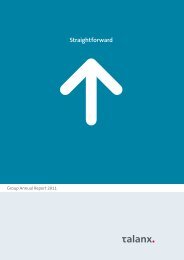ONE ROOF
ONE ROOF
ONE ROOF
Create successful ePaper yourself
Turn your PDF publications into a flip-book with our unique Google optimized e-Paper software.
Notes to the Consolidated Financial Statements<br />
144 Annual Report 2009<br />
IFRS 9 Financial Instruments:<br />
The IASB issued IFRS 9 on November 12, 2009. This represents<br />
the first phase of a three-phase project to replace IAS 39 and<br />
relates to the classification and measurement of financial instruments.<br />
As the remaining phases are completed, new requirements<br />
will be incorporated into IFRS 9 and the corresponding<br />
parts of IAS 39 withdrawn. Under the new standard,<br />
there will be only two measurement categories for financial instruments:<br />
• At fair value through profit or loss;<br />
• Amortized cost.<br />
For an investment in an equity instrument not held for trading,<br />
the entity may make an irrevocable election at the time of initial<br />
recognition to present subsequent changes in the fair value of<br />
the investment, including proceeds on disposal, in other comprehensive<br />
income. The sole exception from this rule relates to<br />
dividends received from such investments, which are recognized<br />
in profit or loss.<br />
The standard is applied retrospectively for all financial assets<br />
at the date of initial application. The date of initial application is<br />
the first fiscal year beginning on or after January 1, 2013. EU<br />
endorsement is still pending. The new standard will result in a<br />
reclassification of financial instruments at HOCHTIEF. Due to<br />
measurement at fair value through profit or loss, changes in<br />
the fair value of financial instruments will have a greater impact<br />
on the Statement of Earnings.<br />
The IASB has also published an omnibus standard as part<br />
of its annual improvements process. This compiles small, nonurgent<br />
but necessary changes to various individual standards<br />
in a single new pronouncement. Most of the changes apply to<br />
fiscal years beginning on or after January 1, 2010 and will not<br />
have any material impact on HOCHTIEF. EU endorsement is<br />
still pending.<br />
IFRIC 12 Service Concession Arrangements:<br />
IFRIC 12 closes a gap in IFRS as regards accounting for rights<br />
and obligations under service concessions granted to privatesector<br />
operators by government or government agencies in<br />
order to provide public services. The Interpretation solely addresses<br />
the accounting by private-sector operators. The applicable<br />
accounting treatment depends on whether the operator<br />
has an unconditional contractual right to payment or merely<br />
a right to charge based on the usage of services. In the first<br />
instance, the “financial asset model” is applied and a financial<br />
asset is recognized. In the second, the operator acquires an<br />
intangible asset permitting it to operate public infrastructure;<br />
that is, the “intangible asset model” is applied. In instances<br />
where an operator receives a fixed amount from the grantor<br />
and a right to charge users so that the ability to earn any excess<br />
over the fixed amount depends on intensity of use, a financial<br />
asset is recognized for the fixed amount and an intangible<br />
asset is recognized for the right to charge users. IFRIC<br />
12 was intended to be effective for annual periods beginning<br />
on or after January 1, 2008. The EU has endorsed the standard<br />
with a different date of initial application to that stipulated<br />
by the IASB. IFRIC 12 consequently applies in the first fiscal<br />
year beginning after March 29, 2009. For HOCHTIEF, applying<br />
this interpretation will essentially only affect accounting for<br />
service concessions to which the intangible asset model applies<br />
(for example, in the case of toll roads and airports). Application<br />
of the new rules to such concessions may change the<br />
allocation of contract net profit among individual reporting periods<br />
during the operating phase. Service concessions that<br />
come under the financial asset model (for example, in the case<br />
of schools) are already largely accounted for at HOCHTIEF in<br />
accordance with the new rules.<br />
IFRIC 16 Hedges of a Net Investment in a Foreign<br />
Operation:<br />
This interpretation clarifies issues relating to net investments in<br />
foreign operations. It stipulates that hedge accounting may be<br />
applied only to foreign exchange differences arising between<br />
the functional currency of the foreign operation and the (immediate,<br />
intermediate or ultimate) parent entity’s functional currency.<br />
Under the prior rules applicable in the EU, the hedging<br />
instrument may be held by any entity within the group—except<br />
the foreign operation being hedged. IFRIC has now lifted this<br />
restriction. IFRIC 16 is applicable in the EU for the first fiscal<br />
year beginning after June 30, 2009. The clarifications will not<br />
materially affect financial reporting at HOCHTIEF.
















